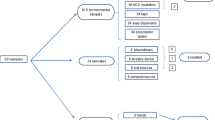Abstract
Nosocomial neonatal candidiasis is a major problem in infants, which require intensive therapy. The subjects of the present study were three preterm infants admitted to the neonatal intensive care unit of the General Hospital “Dr. Manuel Gea Gonzalez”. The infants developed Candida parapsilosis infection on the mean age of 13.6 day of life. Prior to fungemia, infants had received assisted ventilation and hyperalimentation through central venous catheter. Sequence analysis of the internal transcribed spacer gene ruled out other Candida species and revealed that the eight isolates were C. parapsilosis. The isolates were examined based on their molecular relation by random amplified polymorphic DNA analysis. The profiles allowed the identification of two main genotypes of C. parapsilosis as the outbreak cause and as a result of the cross-infection with health care workers’ hands. We conclude that C. parapsilosis commonly colonize through horizontal transmission due to the staff’s noncompliance of hand hygiene procedures.

Similar content being viewed by others
References
Almirante B, Rodríguez D, Cuenca-Estrella M et al (2006) Epidemiology, risk factors, and prognosis of Candida parapsilosis bloodstream infections: case-control population-based surveillance study of patients in Barcelona, Spain, from 2002 to 2003. J Clin Microbiol 44:1681–1685
Asadzadeh M, Ahmad S, Al-Sweih N et al (2009) Rapid molecular differentiation and genotypic heterogeneity among Candida parapsilosis and Candida orthopsilosis strains isolated from clinical specimens in Kuwait. J Med Microbiol 58:745–752
Benjamin DK Jr, Ross K, McKinney RE et al (2000) When to suspect fungal infection in neonates: a clinical Comparison of Candida albicans and Candida parapsilosis fungemia with coagulase-negative staphylococcal bacteremia. Pediatrics 106:712–718
Boldo XM, Villa-Tanaca L, Zúñiga G et al (2003) Genetic diversity among clinical isolates of Candida glabrata analyzed by randomly amplified polymorphic DNA and multilocus enzyme electrophoresis analyses. J Clin Microbiol 41:4799–4804
Cheng MF, Yang YL, Yao TJ et al (2005) Risk factors for fatal candidemia caused by Candida albicans and non-albicans Candida species. BMC Infect Dis 5:22
Clark TA, Slavinski SA, Morgan J et al (2004) Epidemiologic and molecular characterization of an outbreak of Candida parapsilosis bloodstream infections in a community hospital. J Clin Microbiol 42:4468–4472
Durán E, Ramírez de Ocáriz I, Ventura P et al (2005) Candidemia: Candida parapsilosis in a neonatology unit. Rev Iberoam Micol 22:64
Hartung de Capriles C, Mata-Essayag S, Azpiróz A et al (2005) Neonatal candidiasis in Venezuela: clinical and epidemiological aspects. Rev Latinoam Microbiol 47:11–20
Huang YC, Lin TY, Leu HS et al (1999) Outbreak of Candida parapsilosis fungemia in neonatal intensive care units: clinical implications and genotyping analysis. Infection 27:97–102
Kocsubé S, Tóth M, Vágvölgyi C et al (2007) Occurrence and genetic variability of Candida parapsilosis sensu lato in Hungary. J Med Microbiol 56:190–195
Leibovitz E (2002) Neonatal candidosis: clinical picture, management controversies and consensus, and new therapeutic options. J Antimicrob Chemother 49:69–73
Lockhart SR, Messer SA, Pfaller MA et al (2008) Lodderomyces elongisporus masquerading as Candida parapsilosis as a cause of bloodstream infections. J Clin Microbiol 46:374–376
Lupetti A, Tavanti A, Davini P et al (2002) Horizontal transmission of Candida parapsilosis candidemia in a neonatal intensive care unit. J Clin Microbiol 40:2363–2369
National Committee for Clinical Laboratory Standards (2002). Reference method for broth dilution antifungal susceptibility testing of yeasts. Approved standard M27-A2, National Committee for Clinical Laboratory Standards, Villanova, PA
Petersen NJ, Collins DE, Marshall JH (1973) A microbiological assay technique for hands. Health Lab Sci 10:18–22
Phillips G, Golledge C (1991) Fungal infections in neonates. J Antimicrob Chemother 28:159–161
Posteraro B, Bruno S, Boccia S et al (2004) Candida parapsilosis bloodstream infection in pediatric oncology patients: results of an epidemiologic investigation. Infect Control Hosp Epidemiol 25:641–645
Roilides E, Farmaki E, Evdoridou J et al (2004) Neonatal candidiasis: analysis of epidemiology, drug susceptibility, and molecular typing of causative isolates. Eur J Clin Microbiol Infect Dis 23:745–750
Ruiz-Diez B, Martinez V, Alvarez M et al (1997) Molecular tracking of Candida albicans in a neonatal intensive care unit: long-term colonizations versus catheter-related infections. J Clin Microbiol 35:3032–3036
Sarvikivi E, Lyytikäinen O, Soll DR (2005) Emergence of fluconazole resistance in a Candida parapsilosis strain that caused infections in a neonatal intensive care unit. J Clin Microbiol 43:2729–2735
Tay ST, Na SL, Chong J (2009) Molecular differentiation and antifungal susceptibilities of Candida parapsilosis isolated from patients with bloodstream infections. J Med Microbiol 58:185–191
Valério HM, Botelho WR, de Resende MA (2006) Differentiation of Candida species obtained from nosocomial candidemia using RAPD-PCR technique. Rev Soc Bras Med Trop 39:174–178
Van Asbeck EC, Huang YC, Markham AN et al (2007) Candida parapsilosis fungemia in neonates: genotyping results suggest healthcare workers hands as source, and review of published studies. Mycopathologia 164:287–293
Acknowledgments
The authors acknowledge Jorge Yañez and Eugenio López Bustos from the Unidad de Síntesis del Instituto de Biotecnología de la Universidad Nacional Autónoma de México (Cuernavaca, Morelos, México) for the oligonucleotide synthesis and sequencing services.
The authors declare that they have no conflict of interest.
Author information
Authors and Affiliations
Corresponding author
Rights and permissions
About this article
Cite this article
Hernández-Castro, R., Arroyo-Escalante, S., Carrillo-Casas, E.M. et al. Outbreak of Candida parapsilosis in a neonatal intensive care unit: a health care workers source. Eur J Pediatr 169, 783–787 (2010). https://doi.org/10.1007/s00431-009-1109-7
Received:
Accepted:
Published:
Issue Date:
DOI: https://doi.org/10.1007/s00431-009-1109-7




